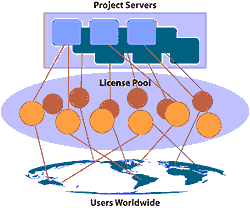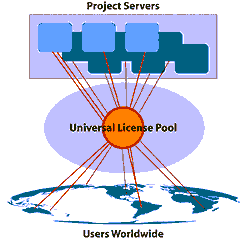Licensing: Software by the numbers
by Alan Joch
Think of a pirate. It’s not an image you might associate with architects, unless perhaps you’re Bob Kruger, vice president for enforcement for the Business Software Alliance (BSA) in Washington, D.C.
The BSA, an industry group composed of software heavyweights such as Microsoft, Adobe, Apple, Autodesk, and Bentley Systems, considers anyone who makes illegal copies of commercial applications a pirate. Kruger says a “fair number” of them are CAD users within the architecture industry. “Most of the companies we investigate are not fly-by-night operations,” he says. “They’re good, well-managed companies that pay taxes and obey Occupational Safety & Health Administration requirements. But when it comes to software management, they have a blind spot.”
Architects are not alone. Across all industries, about a quarter of the commercial software in the U.S. is being used illegally, representing approximately $2.6 billion in lost revenues for software companies, according to the BSA. In response, the group is becoming more aggressive—some say excessively so—in enforcing licensing agreements. Currently, 500 companies are negotiating with BSA lawyers to resolve compliance issues. Over the past 12 years, the organization has received more than $83 million in penalties.
Claims can include fines of up to $150,000 for each copyright infringement, in addition to charges of two to three times the standard price for any software a violator must purchase so that the number of licenses they own is equal to the number of people using the software. In extreme cases, software vendors may attempt to recover profits attributable to their software in court, a potentially deadly blow to an architectural office that routinely uses CAD applications. License violators may also face prosecution under federal copyright laws, which carry maximum fines of $250,000 and jail time.
Getting religion
Almost all of the BSA’s enforcement cases begin with a lead submitted to its “hotline” by a disgruntled employee who reports an employer that is out of compliance. If BSA investigators find merit in the claim, they usually send the alleged violator a warning letter designed to instill fear. Some letters even advise the software user to close down its business until any licensing discrepancies are resolved, says Robert Zielinski, chair of the intellectual property and information technology practice at Wolf, Block, Schorr and Solis-Cohen, a Philadelphia law firm.

Most software makers offer only individually licensed copies of their products (diagram, far left). But Autodesk and Bentley Systems offer network server licenses for their CAD software, in which license information resides in a single place (near left). Users are notified automatically in cases of noncompliance.

Images: Courtesy Bentley Systems
Zielinski says these letters are becoming more commonplace, with more of them going to smaller companies that may once have felt they could fly under the radar screens of big software vendors. “Before they receive a letter, these companies don’t understand the importance of software licenses,” Zielinski says. “But once the letter comes, they get religion very quickly.”
Besides the emotional jolt, a letter can also be a budget buster, even for companies in compliance. One IT director for an architecture firm says his former employer spent almost $10,000 in staff time to document all its Microsoft software licenses after it received a compliance letter, even though they had the required number of licenses.
The BSA contends that accounting for licenses is straightforward. “You’re just adding up the number of software programs you’re using and checking it against how many software licenses you own,” Kruger says. But users believe that even conscientious companies can easily run afoul of overly complex agreements. One “gotcha” comes when companies recycle old computers. For example, a designer who receives a new workstation may pass down her old computer to somebody within the administrative staff, without deleting the CAD software that was on the machine. The software may never be used again, but because it still resides on the hard drive, it may turn up as a violation in a software audit.
Other people become confused by the myriad license types offered by software companies. Some allow registered users to legally install software on both a desktop and notebook computer, while other agreements limit usage to a single computer. Also, IT managers may find themselves constantly working to keep staff members from loading software brought in from the outside. “When you have zillions of computers in a company, it’s hard to make sure nothing sneaks in,” says Peter Theis, IT director at Roger Ferris + Partners in Westport, Connecticut.
Of course, some noncompliance cases involve the outright disregard of agreements by companies trying to cut costs for expensive software, particularly CAD programs, which cost upwards of $2,000 to $3,000 per seat. Other scofflaws flaunt what they consider to be unfair and restrictive license agreements. For example, some agreements give software vendors the right to enter a business to perform an audit whenever it suspects a violation. “Some of this stuff is sickening,” says one architect in the Northeast.
“When you use the term ‘piracy,’ you’re making an analogy that’s way over the top,” says Bradley Kuhn, executive director of the Free Software Foundation, a Boston-based group that advocates the development of freely distributed “open source” software, such as the popular Linux operating system. He believes current licensing policies and “tip lines” foster distrust among coworkers, and that a new business model built on freely distributed source code is the answer to copyright infringement problems.
Kuhn concedes the handful of free CAD programs now under development are not yet ready for prime time, but he believes that situation could change if more professionals supported the free software movement. “If consumers took half the money they’re paying for CAD licenses every year and gave it to some free software project, [open source versions] could be developed and people wouldn’t have to pay for licenses anymore,” Kuhn says.
Compliance strategies
Since market-ready, open-source CAD applications won’t be available anytime soon, how can architects make sure their company avoids a threatening letter from the BSA enforcement division? The first step is for upper management to articulate a formal policy regarding licensing, says Ken Sanders, FAIA, chief technology officer for Gensler in San Francisco. “Architects have a reasonable expectation that clients will comply with the terms of the contracts they sign—so it’s reasonable for us to comply with the software licenses we sign, even if we don’t always think they’re the best terms,” he says.
In addition to communicating that philosophy to employees, Sanders says senior managers must be committed to such compliance in their own minds. “If you express ambiguity, people take cues from that,” he says. “You need to sit down and talk from the standpoint of how acting this way is part of being a good citizen. You may not agree with all the copyright laws and think it’s not reasonable to restrict the use of software, but at the end of day, when comes down to an agreement you have signed with another party, you must honor it.”
To ease the logistics of compliance, IT directors suggest purchasing network server licenses of software applications whenever possible. In this model, a predetermined number of “seats”—say 10 licenses of a CAD application for a department of 15 designers—reside on a single server. Any 10 people may use the application at a given time, but the system locks out additional users until somebody logs off. This relieves architects from constantly monitoring usage to make sure no one is using a program illegally. Currently, Autodesk and Bentley Systems offer this licensing arrangement for their respective products. However, other vendors important to architecture firms, including Microsoft and Adobe, don’t provide these types of licenses. “This means we have to manually keep track of, for instance, who has Photoshop installed in each machine, which is difficult,” says James Brogan, AIA, IT director for Kohn Pedersen Fox. “I’m disappointed there isn’t a server license for these other software packages.”
Third-party auditing programs are also available to help IT departments keep accurate records of licenses and software installations.
Theis, of Roger Ferris + Partners, says architecture firms, especially larger ones, that don’t make use of auditing software face “a nightmare” trying to comply with licenses. “You could spend hundreds of hours” matching what’s on each computer to a master list of licenses, he says.
Keeping this information in an electronic record helps a company not only stay in compliance, but also know where it stands if an audit letter arrives. If that happens, Zielinski tells his clients to respond quickly and honestly, even if they’re not in compliance. “We counsel clients never to swap out hard drives or reformat disks [to hide illegal software copies]. That only makes things worse and really makes you look guilty.” Instead, he says, companies should conduct internal audits to understand how they got out of compliance and what they need to do to resolve the problem. The subsequent fines may be stiff, but this avoids walking the plank into a federal courthouse.
First published April 3, 2003


